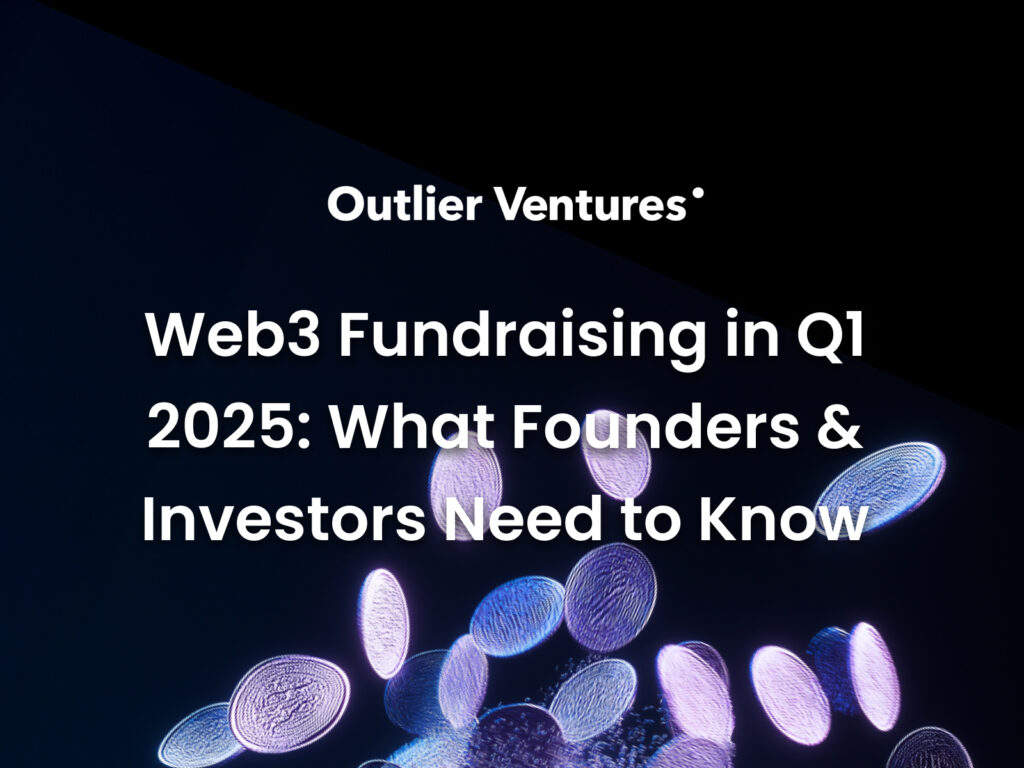This article was written by Matthew Dawson, Dimitrios Chatziagnoustou, and Jamie Burke.
The Concept of Token Gravity
In the rapidly evolving landscape of blockchain and cryptocurrencies, a powerful new force is emerging: Token Gravity. Originally conceptualised by Outlier Ventures in 2017, Token Gravity is becoming increasingly relevant as the blockchain landscape matures. What began as a theoretical framework for understanding the consolidation of digital assets is now observable in how capital and community dynamics shape the growth of tokenized ecosystems.
“Token Gravity” describes the gravitational pull that large, well-capitalised tokens exert on smaller tokens, attracting them into a unified orbit. Much like planets that draw objects into their orbit, larger tokens attract smaller ones through their economic mass, which includes liquidity, market presence, technological competitiveness, culture and community engagement. As these tokens grow, their gravitational pull becomes stronger, influencing smaller projects to align with or integrate into their ecosystems.
Token Gravity is driven by three main forces: capital, which provides liquidity and stability; community, which fosters network effects and brand loyalty; and technology, which enables value creation and growth. While capital often plays a dominant role, the synergy between community engagement and technological innovation is what sustains the gravitational pull over time. This trend is unfolding in real-time, as seen with the Artificial SuperIntelligence Alliance ($ASI) merger within the Outlier Ventures portfolio. In this case, multiple projects unified under a single token, leveraging shared liquidity and market presence to create a stronger, more integrated and dominant ecosystem.
The Wall of Token Supply
The crypto market is facing a critical challenge: an impending oversupply of tokens that threatens to overwhelm existing demand. This influx is creating intense competition for attention and capital among new and existing projects. With the barriers to launching new tokens lower than ever, the market is experiencing a surge in token issuance. Thousands of new tokens, each with unique propositions, are vying for a slice of the market’s limited attention and capital. In this crowded space, many projects struggle to stand out, leading to a growing number of undercapitalized assets.
This surge of new tokens is creating a Darwinian thinning in the market. Projects with weak capital reserves, shallow liquidity, and limited community support face increasing pressure to differentiate themselves or face extinction. Only those with strong collaboration, capital backing, robust infrastructure, and strategic alignment with larger ecosystems can withstand the competitive forces at play.
For new projects, survival depends on strategic choices. Many will seek to integrate with larger ecosystem players, leveraging their liquidity and infrastructure to gain a foothold in the market. Others may focus on building a niche community and developing unique technological advantages to differentiate themselves. In either case, navigating this oversupply requires a careful balancing of short-term growth tactics with long-term sustainability. By understanding these dynamics, founders and investors can better position themselves in a market that is increasingly dominated by larger players. Recognizing the challenges posed by this wall of token supply is the first step toward thriving in an environment where partnerships and strategic alliances have become essential for success.
The Rise of Category Tokens
As the crypto market matures, a new class of digital assets is emerging: Category Tokens. These are large cap tokens that serve as de facto representatives for entire industries, acting as anchors for liquidity, community engagement, and technological innovation. Category Tokens provide a cohesive framework for smaller projects, enabling a more organised and integrated market structure.
Instead of hundreds of niche tokens competing for visibility and liquidity, Category Tokens offer a more efficient way to concentrate economic activity. They provide a robust infrastructure that includes deep liquidity pools, established community bases, and competitive technology, making it easier for smaller projects to plug into existing ecosystems rather than building from scratch. Improvements in blockchain technology, facilitating easier interoperability, such as cross-chain compatibility, is an enabling force for the growth in merger activity.
Category Tokens act as hubs that generate network effects, where the value of the network increases as more projects integrate. These network effects make it increasingly difficult for smaller tokens to compete independently, as aligning with a Category Token allows them to leverage a shared user base, liquidity, and market presence. Over time, this consolidation leads to more efficient and interconnected market sectors. While the integration of smaller projects into Category Tokens can drive growth, it is not without challenges. Aligning governance models, ensuring fair value capture for all participants, and maintaining technological compatibility can be complex. Additionally, some projects may resist integration to preserve their autonomy and token value upside potential, even if it means facing greater competitive pressure. Despite these challenges, the gravitational pull of Category Tokens remains strong for those seeking quicker access to liquidity and user networks.
Memetic value, or the ability to capture attention and mindshare, has increasingly become a driving factor of success for tokens. In a market where differentiation is increasingly difficult, “everything is, to an extent, a memecoin” as Jamie Burke, Founder of Outlier Ventures puts it. This means tokens often rely on their capacity to generate hype and momentum, ideally supported by fundamentals, but often in their absence. Tokens also compete for attention within their category, that battle is driven largely by community engagement and social visibility. In the absence of fundamental analysis, many investors will choose to invest in tokens not because of their inherent value, but because they believe others will also invest. This chicken and egg situation again places Category Tokens at the forefront, as projects need investment to justify their value, which only emerges if there is prevalent market interest. As a result, the speculative nature of the market amplifies the importance of memetic value, tokens must not only have strong fundamentals but also succeed in capturing attention.
Token Gravity as a Strategic Moat: The Role of Capital, Community, and Technology
Token Gravity creates a strategic moat within Web3, drawing projects into its orbit through a combination of capital strength, community engagement, and technological integration. These elements, when aligned, transform larger tokens into powerful hubs that shape the dynamics of the crypto ecosystem.
Capital forms the bedrock of Token Gravity, enabling tokens to secure deep liquidity pools, attract institutional investors, and fund strategic partnerships or growth through mergers and acquisitions (M&A). This financial strength allows tokens to create a flywheel effect where greater liquidity and investment attracts more users and investors.
Culture is a force that sustains and amplifies a token’s gravitational pull. As Vitalik said “Culture has a similar effect to incentives – indeed, culture is part of incentives. It affects who is attracted to an ecosystem and who is repelled”. An active and loyal user base is not just a source of network effects but a driver of organic growth. These communities rally around a token, creating a sense of belonging that attracts new users and projects. For smaller projects, aligning with a strong community can be the difference between obscurity and accelerated adoption.
Technology is the backbone that enables seamless integrations and enhances interoperability within a token’s ecosystem. Tokens with well developed technical frameworks can make integration easier, but these technical benefits must be matched with capital to fuel growth and community support to sustain user engagement. Projects often face trade-offs, where a technically superior protocol may lose out to a well-capitalised competitor with a larger community, highlighting the need for a balanced approach.
The real strength of Token Gravity lies in the synergy between capital, community, and technology. When these elements align, they create a self-reinforcing ecosystem that attracts new projects, nurtures innovation, and drives long-term growth. This dynamic allows smaller tokens to gain access to liquidity and infrastructure, while larger tokens solidify their roles as foundational pillars in the decentralised economy, shaping the future of Web3 through strategic M&A.
The Institutional Shift
As token consolidation reshapes the market, demand is shifting from retail-driven speculation to strategic, long-term investments by institutions. Institutional capital flows into tokens that offer deep liquidity, strong governance, and stability, qualities that make Category Tokens ideal targets. Institutional investors prioritise deep liquidity, secure investment environments, and consistent market depth, seeking assets that can accommodate large transactions without significant price impact. Unlike retail investors, often drawn to speculative tokens, institutions focus on assets that offer long-term stability and growth potential, making Category Tokens their preferred choice. This shift creates a feedback loop: as institutional capital flows into Category Tokens, it deepens their liquidity and boosts market value, further enhancing their appeal. This growth attracts additional investment, reinforcing their dominance and expanding their influence across the market.
Category Tokens have the potential to behave like index funds in traditional markets, providing easy and efficient methods to allocate to a sector. As categories mature, dominant tokens in these sectors increasingly become representatives of their entire niche, much like an ETF or index. For institutions, investing in a Category Token simplifies the investment process. Institutions can allocate capital to a token that captures the economic activity of an entire category, in lieu of attempting to pick individual winners within a sector, where liquidity and maturity are far riskier.
Despite many tokens being stuck in the competition for memetic value, we believe that certain categories will break away from this dynamic due to their connection with real world data components namely, DeAI, DePIN and RWA. These categories have a stronger tie to tangible, measurable data and use cases, which will increasingly attract the attention of retail and institutional investors alike.
A Case Study in Token Gravity: The $ASI Merger
As the world’s oldest and most active accelerator with a cohesive thesis, Outlier Ventures has witnessed the dynamics of token gravity unfold firsthand. Within OV’s portfolio, a notable example is the $ASI merger, where fetch.ai, SingularityNET and Ocean Protocol, merged into a unified token, allowing $ASI to dominate its category. This merger is just the beginning, with $ASI continuing their merger strategy with the addition of $CUDOS.
The merger into $ASI illustrates the real-world power of token gravity. By pooling resources, capital, and market influence, $ASI is evolving into a Category Token, drawing smaller projects into its ecosystem and solidifying its leadership within the sector. This trend extends beyond $ASI. We are observing similar patterns of consolidation across sectors like DeAI, DePIN, and Real World Assets. As these areas mature, the gravitational pull of well-capitalised tokens will continue to strengthen, driving further integration, consolidation, and sectoral growth.
The Future of Token Consolidation
The future of the token economy is being shaped by the forces of token gravity. As the market matures, a few dominant Category Tokens will continue to attract capital, projects, and users, creating a more stable and interconnected ecosystem. This shift presents opportunities for both established players and new entrants, but it also demands strategic adaptation.
Capital liquidity is a major component of Token Gravity. Listings on major exchanges can be prohibitively expensive and take years to achieve, a timeline that’s only extending as exchanges become more selective. This introduces a significant barrier to new entrants, even if they have superior technology. No matter how innovative a project, building out the necessary infrastructure; exchange listings, liquidity pools and partnerships, takes considerable time. Institutional investors require deep liquidity and reliable infrastructure. Considering this, new entrants face an uphill battle to establish themselves in the market. They need time to build the capital, community and liquidity needed to compete with larger, more established Category Tokens. Therefore, Token Gravity benefits the incumbents, who already have the necessary moats to allow them to continue attracting attention and capital over time.
For larger tokens, the focus should be on leveraging their gravitational pull to drive growth and absorb innovation. Meanwhile, new projects must navigate a complex landscape by either integrating into existing ecosystems or building distinctive value propositions and culture that can thrive independently. Understanding these dynamics is crucial for founders and investors alike. Those who can align their strategies with the emerging patterns of consolidation and adapt to the evolving market will be best positioned to thrive in the next phase of the decentralised economy.
In upcoming articles, we’ll dive into the practical aspects of Web3 M&A, examining the latest trends and strategies from the perspectives of both established players looking to drive growth and new entrants aiming to carve out their space.
Acknowledgement
Thanks to Achim Struve, Matthis Herbrecht and Raffaele Geneletti for their contributions and feedback on this article.





